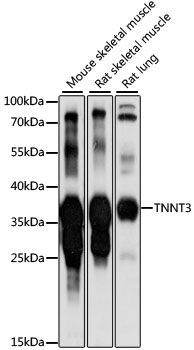| Background: | The binding of Ca(2+) to the trimeric troponin complex initiates the process of muscle contraction. Increased Ca(2+) concentrations produce a conformational change in the troponin complex that is transmitted to tropomyosin dimers situated along actin filaments. The altered conformation permits increased interaction between a myosin head and an actin filament which, ultimately, produces a muscle contraction. The troponin complex has protein subunits C, I, and T. Subunit C binds Ca(2+) and subunit I binds to actin and inhibits actin-myosin interaction. Subunit T binds the troponin complex to the tropomyosin complex and is also required for Ca(2+)-mediated activation of actomyosin ATPase activity. There are 3 different troponin T genes that encode tissue-specific isoforms of subunit T for fast skeletal-, slow skeletal-, and cardiac-muscle. This gene encodes fast skeletal troponin T protein; also known as troponin T type 3. Alternative splicing results in multiple transcript variants encoding additional distinct troponin T type 3 isoforms. A developmentally regulated switch between fetal/neonatal and adult troponin T type 3 isoforms occurs. Additional splice variants have been described but their biological validity has not been established. Mutations in this gene may cause distal arthrogryposis multiplex congenita type 2B (DA2B). |
| UniProt Protein Function: | Troponin T is the tropomyosin-binding subunit of troponin, the thin filament regulatory complex which confers calcium-sensitivity to striated muscle actomyosin ATPase activity. |
| NCBI Summary: | The binding of Ca(2+) to the trimeric troponin complex initiates the process of muscle contraction. Increased Ca(2+) concentrations produce a conformational change in the troponin complex that is transmitted to tropomyosin dimers situated along actin filaments. The altered conformation permits increased interaction between a myosin head and an actin filament which, ultimately, produces a muscle contraction. The troponin complex has protein subunits C, I, and T. Subunit C binds Ca(2+) and subunit I binds to actin and inhibits actin-myosin interaction. Subunit T binds the troponin complex to the tropomyosin complex and is also required for Ca(2+)-mediated activation of actomyosin ATPase activity. There are 3 different troponin T genes that encode tissue-specific isoforms of subunit T for fast skeletal-, slow skeletal-, and cardiac-muscle. This gene encodes fast skeletal troponin T protein; also known as troponin T type 3. Alternative splicing results in multiple transcript variants encoding additional distinct troponin T type 3 isoforms. A developmentally regulated switch between fetal/neonatal and adult troponin T type 3 isoforms occurs. Additional splice variants have been described but their biological validity has not been established. Mutations in this gene may cause distal arthrogryposis multiplex congenita type 2B (DA2B). [provided by RefSeq, Oct 2009] |
| UniProt Code: | P45378 |
| NCBI GenInfo Identifier: | 33518637 |
| NCBI Gene ID: | 7140 |
| NCBI Accession: | P45378.3 |
| UniProt Secondary Accession: | P45378,Q12975, Q12976, Q12977, Q12978, Q17RG9, A8MQ76 A8MSW1, B3KPX3, B7WP64, B7ZL26, B7ZVV9, |
| UniProt Related Accession: | P45378 |
| Molecular Weight: | 29,735 Da |
| NCBI Full Name: | Troponin T, fast skeletal muscle |
| NCBI Synonym Full Names: | troponin T3, fast skeletal type |
| NCBI Official Symbol: | TNNT3 |
| NCBI Official Synonym Symbols: | TNTF |
| NCBI Protein Information: | troponin T, fast skeletal muscle |
| UniProt Protein Name: | Troponin T, fast skeletal muscle |
| UniProt Synonym Protein Names: | Beta-TnTF; Fast skeletal muscle troponin T; fTnT |
| Protein Family: | Troponin |
| UniProt Gene Name: | TNNT3 |
| UniProt Entry Name: | TNNT3_HUMAN |







